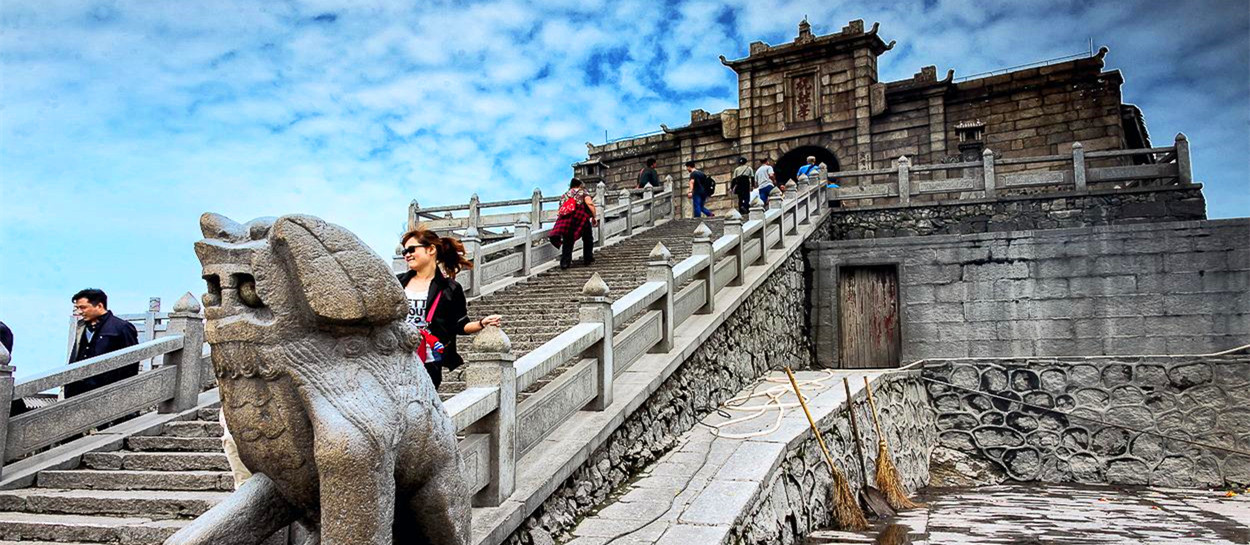008613762194311 | 008613762194311 tour-zhangjiajie@outlook.com
008613762194311 | 008613762194311 tour-zhangjiajie@outlook.com
The Hengshan Mountain, one of " the Five High Mountains" in China, towers on the southwestern bank of the Xiang River in its middle reaches. Known for its charming scenery and rich Buddhist and Daoist culture, it has been designed as a key scenic area at the state level.
★ Fast Facts on Hengshan Mountain
■ Chinese name: 南岳衡山
■ Main Scenic Spots: Zhu Rong Peak, The His-Majusty-Blessing Temple
■ Admission fee: 100RMB/PAX
■ Suitable for: Hiking Lovers, Buddhist and Daoism
 The Hengshan Mountain, a sacred place of Buddhist and Daoism, has given birth to accomplished monks and Daoists in every dynasty. Different from other " High Mountains" or " Sacred Mountains", it accommodates religious people of both Buddhism and Daoism. Their coexistence, rarely seen in religious histories, is well illustrated by the Grand Temple to the God of the South High Mountain, the largest and best-preserved ancient architectural complex in the South China. Its east wings are eight Daoist monasteries and its west wings eight Buddhist temples, while the gateways, pavilions, halls and palacea arranged along the central axis have been jointly operated since the Ming dynasty. Besides, " Saint Zhao, Emperor of Heaven", the idolworshiped here, is actually a combination of Confucianism, Buddhist and Daoism.
The Hengshan Mountain, a sacred place of Buddhist and Daoism, has given birth to accomplished monks and Daoists in every dynasty. Different from other " High Mountains" or " Sacred Mountains", it accommodates religious people of both Buddhism and Daoism. Their coexistence, rarely seen in religious histories, is well illustrated by the Grand Temple to the God of the South High Mountain, the largest and best-preserved ancient architectural complex in the South China. Its east wings are eight Daoist monasteries and its west wings eight Buddhist temples, while the gateways, pavilions, halls and palacea arranged along the central axis have been jointly operated since the Ming dynasty. Besides, " Saint Zhao, Emperor of Heaven", the idolworshiped here, is actually a combination of Confucianism, Buddhist and Daoism.
The Grand Temple to God of the South High Mountain is situated in the north of the South High Mountain Town at the southern foot of the Red Emperor's Peak. It consists of nine rows of magnificent and resplendent buildings with upturned eaves, and proves to be the largest and best-preserved ancient architectural complex in the palatial style in South China. It presents eight Daoist monasteries in the east and eight Buddhist temples in the west. Here, Daoism and Buddhism and Confucianism coexist peacefully, which is indeed a wonder in the history of religion.
The Grand Temple dates back to a certain age in the Qin or Han dynasty. Originally built on the Zhurong Peak, it was later moved to the foot of the mountain to facilitate religious activities. The Grand Temple, fenced by a red wall, covers an area of some 100,000m² from south to north lies a sequence of four courtyards enclosed by building in nine rows. The whole architectural complex stretches along the meridian central axis, which links up all the halls. The winding verandas and the side buildings serve as a foil to the main buildings, which thus seen all the more grand and splendid.
The His-Majesty-Blessing Temple, located at the end of the East Street of the down, is the largest foil all extant Buddhist temples at the Hengshan Mountain. It is known as the cradle of Cheng Yuan and Fa Zhao, respectively the third and fourth successors to the founder of the Pure Land Sect. Standing among old pine trees and cypresses, it is free from the hustle and bustle of downtown life nearby, which provides a favorable condition for the religious practice.
In 1705, Zhao Shenqiao, governor of Hunan, had the temple extended into an imperial palace to accommodate Emperor Kangxi, who was to go to an inspection tour of the south. Yet, the emperor failed to come, and immediately the quick-thinking governor renamed it " the His-Majesty-Blessing Temple". With the help of the authorities, it has been renovated in recent years so that it puts on a new look today. Covering an area of 10,000m², it boasts over 100 rooms of various sizes, along the central axis are situated the Front Gate, the Second Gate, the Hall of Celestial Guardians, the Hall of Buddha, the Sermon Hall, the Abbot's Hall and 6 courtyards.
Located at the foot of the Talents-Gathering Peak 3KM from the town, the Yellow Courtyard Temple is named after " Canon of the Yellow Courtyard", a scripture by Madame Wei, a women Doaist of the Southern Sect in the Jin dynasty. Built in 334, it was named" Auspicious Tower" in the Jin dynasty, and then renamed " Wei's Tower " in the Tang dynasty.
The temple mainly enshrines the statue of Madame Wei, As a young girl, she had already grasped well " the Five Classics " and " the Books of Lao Zi and Zhuang Zi", which could satisfy her thirst for immortals' stories. In 318, she came to the Auspicious Tower and devoted herself to Daosim. As a result, " at the age of 80, she still looked as young as a virgin". Perfectly cultivated, she finally turned into a celestial being at the age of 84.
Madame Wei started the history of Chinese women practicing Daoism, and the Yellow Courtyard Temple is the cradle of the first women Daoist; Therefore, they both have a good reputation in the Daoist World.
Previous Page:Shaoshan Mountain Village
Next Page: Yueyang Tower